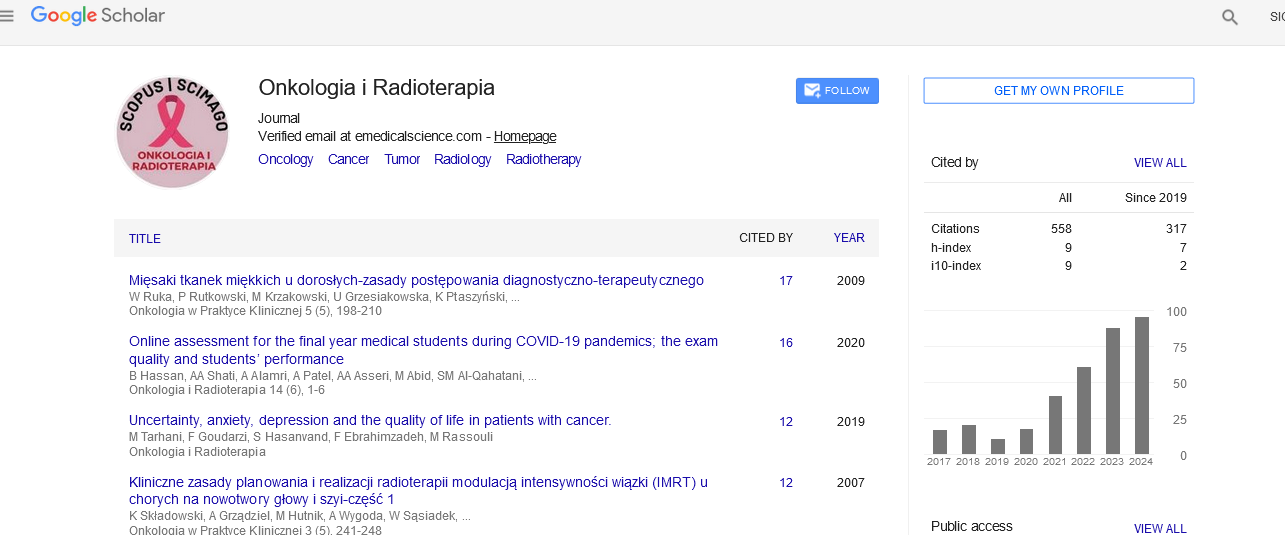Does the mean heart dose remain a valid parameter for assessing early cardiac toxicity following radiotherapy for left-sided breast cancer?
Abstract
Author(s): Nezha Tawfiq*, Salma Guendaoui, Meriem Tantaoui, Karima Bendahhou, Ghita Hatim, Tarik Chekrine, Meryem Belhouari, Mouna Boughafour, Zineb Bouchbika, Nadia Benchakroun, Hassan Jouhadi, Souha Sahraoui, Salah Hayar, Hamza Karmouchi and Rachida Habbal
Context: Adjuvant radiotherapy for left-sided breast cancer improves locoregional control and overall survival. However, irradiation of the cardiac structures increases the risk of radiation-induced cardiotoxicity. The mean heart dose (MHD) is commonly used to estimate this risk, but it does not reflect heterogeneous dose distribution within critical substructures, such as the left ventricle (LV) and left anterior descending artery (LAD). Purpose This study aimed to analyze the dose distribution within cardiac substructures and evaluate the reliability of mean heart dose (MHD) in predicting early radiation-induced myocardial dysfunction. Methods: Fifty patients with left-sided breast cancer who underwent three-dimensional conformal radiotherapy (3D-CRT) at Ibn Rochd University Hospital between 2020 and 2022 were analyzed. The target volumes and cardiac substructures were delineated. The dosimetric parameters of the heart, left ventricle (LV), left anterior descending artery (LAD), and other coronary arteries were statistically evaluated. Echocardiographic assessments, including speckle-tracking imaging, were performed before and after radiotherapy, to detect early myocardial alterations. Results: The mean heart dose (MHD) was 4.9 ± 0.8 Gy, while the left ventricle (LV) received a mean dose of 7.7 ± 2.1 Gy. The left anterior descending artery (LAD) was the most exposed structure with a mean dose of 25.9 ± 3.4 Gy. Pearson correlation analysis revealed a strong association between MHD and the mean LV dose (r = 0.742, p < 0.001), but a weaker correlation with the mean LAD dose (r = 0.460, p < 0.001). Regression analysis demonstrated that MHD had a low predictive value for LAD exposure (R² = 0.21) and moderate predictive value for LV dose (R² = 0.55). Echocardiographic assessment revealed segmental strain impairment in 23% of the patients within the LAD-perfused myocardial territory. The mean LAD dose was significantly higher in the patients with segmental strain abnormalities (30.19 Gy vs. 21 Gy, p = 0.004). In contrast, no significant association was found between MHD and strain abnormalities (p = 0.504). Conclusion: This study demonstrated that the mean heart dose (MHD) is insufficient to accurately assess cardiovascular risk in left-sided breast radiotherapy because it underestimates the actual exposure of the left ventricle and left anterior descending artery (LAD). Therefore, these substructures should be considered distinct organs at risk, and specific dosimetric constraints should be applied to better prevent radiation-induced cardiac complications. Moreover, the use of IMRT techniques, respiratory motion management, and early implementation of strain imaging warrants particular attention to optimize the management of high-risk patients.
Share this article


Editors List
-
RAOUi Yasser
Senior Medical Physicist
-
Ahmed Hussien Alshewered
University of Basrah College of Medicine, Iraq
-
Sudhakar Tummala
Department of Electronics and Communication Engineering SRM University – AP, Andhra Pradesh
-
Alphonse Laya
Supervisor of Biochemistry Lab and PhD. students of Faculty of Science, Department of Chemistry and Department of Chemis
-
Fava Maria Giovanna
Google Scholar citation report
Citations : 558
Onkologia i Radioterapia received 558 citations as per Google Scholar report
Onkologia i Radioterapia peer review process verified at publons
Indexed In
- Directory of Open Access Journals
- Scimago
- SCOPUS
- EBSCO A-Z
- MIAR
- Euro Pub
- Google Scholar
- Medical Project Poland
- PUBMED
- Cancer Index
- Gdansk University of Technology, Ministry Points 20

